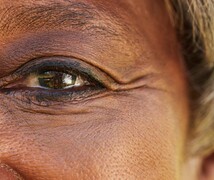Chaz Dawson started wearing glasses when he was 10 years old and switched to contact lenses as a teenager. While corrective lenses helped with his nearsightedness, they also interfered with his active life. By the time he turned 35, he looked into LASIK surgery to correct his vision but was disappointed to learn he wasn’t a candidate. Kourtney Houser, MD, a corneal specialist at Duke Health, recommended that Dawson have photorefractive keratectomy (PRK) surgery instead. He followed her advice and today has 20/20 vision. “It was one of the best decisions I’ve ever made,” he said.
The Burden of Lost Contact Lenses
As a child, Dawson played a variety of sports, then focused on football during college. Even with glasses and contacts, he was still burdened by his poor eyesight. Sometimes his contacts would pop out after getting tackled in games. “My prescription was so strong if my contacts weren't in, I wasn't able to play,” he said. He had to always carry a spare set with him just in case.
Not a Candidate for LASIK Surgery
After college, Dawson stepped away from football. The Durham, NC resident still enjoyed playing sports but was less tolerant of the inconvenience of wearing corrective lenses. Then in June 2022, his wife suggested that he explore LASIK surgery so he could get rid of his glasses and contacts for good. Dawson met with Dr. Houser for an assessment. “LASIK wasn't appropriate for him because of his strong prescription and cornea thickness,” she explained. The higher the prescription, the more cornea that needs to be treated, and Dawson’s cornea was too thin to perform LASIK safely.
PRK, an Alternative to LASIK
Dr. Houser recommended photorefractive keratectomy (PRK), an alternative refractive surgery that can correct nearsightedness, farsightedness, and astigmatism. In PRK surgery, your eye surgeon removes cells on the surface of the eye, and a laser is used to reshape your cornea. In LASIK surgery, a flap is made in the front part of your eye, which is replaced after your cornea is reshaped. During intense activity, such as contact sports, the flap can move or become dislodged, but with PRK, there is no such risk. This made the procedure particularly well-suited to Dawson.
Learn how PRK surgery works.
Seeing 20/20
While recovery is slightly longer for PRK than with LASIK, most people are driving and back to work three days after surgery, said Dr. Houser. Dawson was pleased with the results right away. “I could see better immediately, not perfect, but for someone who was used to waking up in the morning and not being able see anything until I put my glasses or contacts on, I was like, ‘Oh, wow, I can see.’" About a week after surgery, his vision stabilized at 20/20. He no longer needs glasses or contact lenses.
What to Look for in a Laser Vision Center
Dr. Houser advises people interested in refractive surgery go to a center that offers a rigorous evaluation, modern laser technology, and experienced providers. “The hardest part of refractive surgery is determining which procedure is best -- and safest -- for each patient, and that comes with experience,” she said. Duke LASIK and PRK surgeons are board-certified ophthalmologists with advanced training in cornea and refractive surgery. Collectively, they have performed more than 20,000 refractive procedures since Duke began offering them nearly 25 years ago.




